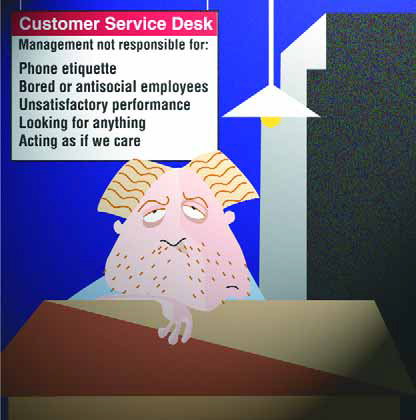Professional Watershaping
To my way of thinking, professional design work requires a professional workspace in which all of the necessary professional tools are available. In fact, for the designer creating custom watershapes, I see the space in which the work actually unfolds as being critical and cutting to the very heart of what it really means to be a "designer." I know that term is a loaded one, which is why I put it in quotation marks. After all, anyone can say that he or she is a designer, even if all they do is sit at a coffee table
It's amazing how many people I meet in the course of my day-to-day life who do not embrace the basic idea that the single most important part of doing business is how they interact with current and prospective clients. Way too often, I'll run into someone - usually an employee, but sometimes (and shockingly) a manager or owner - who just doesn't have a clue or really doesn't seem to care. This happens so often, in fact, that I find my patience growing shorter with the laziness, incompetence or downright rudeness I encounter. It's gotten to the point where I'm
I never really thought much about the plants and trees surrounding me until I started edging my way toward the landscape-design business. Growing up, I'd look out my bedroom window and into our backyard and see plants and trees, but I didn't know that they were called Junipers or Giant Birds of Paradise or Ficus trees. They all looked pretty much the same to me - a generic veil of greenery. My path of discovery began when I bought my first house on Long Island. All of a sudden, there were rules about
Over and over at seminars and trade shows, watershapers ask me three distinct but interrelated questions: "How do you get into the high-end market?" and "How do you deal with wealthy customers?" and "How do you handle those kinds of jobs?" The short answer to all of them is that I've set myself up for it and am prepared to tackle these projects and clients as they come. To me, it's as natural as breathing. The deeper answer is much more complicated, obviously, and has to do with my understanding that working with upper echelon clients means accommodating an entire range of issues that
Many have asked me how it is that my work is published so often. I'm not talking about this column, which is about what I do and occasionally depicts my work to illustrate a point I'm making about what we do as watershapers. Rather, the question's about my projects making their ways into books and consumer magazines and other media beyond WaterShapes. The short answer is that I focus on garnering this sort of exposure and have actively cultivated it through the years. As is the case with anything else you do to draw positive attention to your business, seeking to have your work published in a book or magazine takes time and effort and an understanding of what working with writers and editors is all about. The benefits of
Last month, I jumped into the New Year with a discussion of how the trends we face these days are influencing our recent experiences in business, society and life in general. In doing so, we navigated our through a mixed bag of factors - advancing technology, interesting economic times and complex legal conditions on the grand scale up alongside local, narrower issues having to do with the emergence of the watershaping business, the wayward nature of trade associations and the state of relevant education for our trades. All that was intended to set up this column's discussion of where we, as the watershaping industry, might be going in the months and years to come. Pure prognostication, however, is an imperfect process in which I won't indulge. Rather than get into the aimless game of offering predictions, I'll delve instead into
Some might say we're enduring the curse of living in interesting times; others might opine that the planet's just plain gone crazy. However you look at it, when you stop to consider what's been going on in the world, in our country and in the economy and how all of that relates to our watershaping corner of the universe, it's easy to see that important trends and even greater forces are constantly sweeping around us. So much is happening that it's often difficult to figure things out, but the most important observation I can make is that not all the news is gloomy - far from it. For a great many watershapers, in fact, business has thrived in recent times and expanded in new and exciting directions. That's so true for some that it's fair to say that there's been little or no time left for reflection. But I would argue that finding time to
During the five years I've been writing this column for WaterShapes, I've been asked by a number of people how I manage to find the time to write this column, make presentations at trade shows, teach at Genesis 3 schools and conduct my own design/consulting business. I get the distinct impression that these questions have much less to do with curiosity about the power of time management than with questions about why I'd even bother to extend my focus beyond my primary business of
One of the real tricks in any art form can be the challenge of exercising restraint. Bigger isn't always better, and both scale and size do matter. In other words, just because you can create something grand, it doesn't always mean that you should. This principle of proportionality has a sharp, specific meaning in the world of the custom watershaper, especially when clients ask for something that is oversized for the property or more elaborate than called for by the setting or surrounding architecture. We all know where it comes from: Clients have seen something they like, and it






















